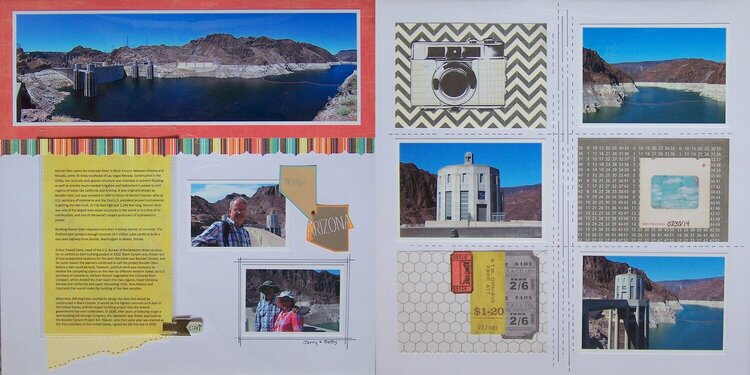
EXTRA 11% OFF Orders $100+ With Code: THANKYOU

 Give a Cheer
Give a Cheer
The journaling is information I got from the internet about the history of Hoover Dam. The panoramic photo is also one I found online and couldn't resist putting it on this page. I had a difficult time getting good pics of these pages because I had to shoot them in their sleeves, due to the pocket flap attached to the left hand page. If you lift the flap there's another whole sheet of journaling underneath. These were just really simple pages, but I wanted to get the history recorded in my album. Thanks for looking...
If you are interested, here's the journaling:
Hoover Dam spans the Colorado River in Black Canyon between Arizona and Nevada, some 30 miles southeast of Las Vegas Nevada. Constructed in the 1930s, the concrete arch-gravity structure was intended to prevent flooding as well as provide much-needed irrigation and hydroelectric power to arid regions of states like California and Arizona. It was originally known as Boulder Dam, but was renamed in 1947 in honor of Herbert Hoover, who as U.S. secretary of commerce and the 31st U.S. president proved instrumental in getting the dam built. At 726 feet high and 1,244 feet long, Hoover Dam was one of the largest man-made structures in the world at the time of its construction, and one of the world’s largest producers of hydroelectric power.
Building Hoover Dam required more than 5 million barrels of concrete. The finished dam contains enough concrete (4.5 million cubic yards) to build a two-lane highway from Seattle, Washington to Miami, Florida.
Arthur Powell Davis, head of the U.S. Bureau of Reclamation drew up plans for an ambitious dam-building project in 1922. Black Canyon was chosen out of two prospective locations for the dam; the other was Boulder Canyon, and for some reason the planners continued to call the project Boulder Dam. Before a dam could be built, however, political work was necessary to resolve the competing claims on the river by different western states. As U.S. secretary of commerce, Herbert Hoover negotiated the Colorado River Compact, which divided the river basin into two regions, lower (Arizona, Nevada and California) and upper (Wyoming, Utah, New Mexico and Colorado) that would make the building of the dam possible.
More than 200 engineers worked to design the dam that would be constructed in Black Canyon. It would be the highest concrete arch dam in the United States, and the largest building project that the federal government had ever undertaken. In 1928, after years of lobbying to get a dam-building bill through Congress, the legislation was finally approved as the Boulder Canyon Project Act. Hoover, who that same year was elected as the 31st president of the United States, signed the bill into law in 1929.
By the time construction of Boulder Dam began in 1930, thousands of prospective workers had flooded the region, many of whom had lost their jobs during first years of the Great Depression. A total of 21,000 men worked on building the dam over the course of its construction (around 5,000 at any one time) and the region’s growing population turned Las Vegas from a sleepy town to a bustling city.
Blistering summer heat and a lack of adequate shelter and services combined with difficult and dangerous working conditions to create a volatile situation, and conflicts arose between the construction firm, Six Companies, and dam workers and their families. The Bureau of Reclamation would later estimate that 107 workers lost their lives while building the dam. Despite these problems, the massive project proceeded relatively quickly, and by the fall of 1935 Boulder Dam was completed.
Some 12,000 people attended the ceremony on September 30, 1935, when President Franklin D. Roosevelt dedicated Boulder Dam. (Twelve years later, the dam would be renamed for Hoover in honor of his efforts on behalf of the project.) At 726 feet (221 m) high–twice the height of the Statue of Liberty–and 1,244 feet (379 m) long, the dam weighs more than 6.6 million tons. At its base, where the maximum water pressure is 45,000 pounds per square foot, are huge generators that could produce up to 3 million horsepower and provide electricity for three states. The building of the dam created Lake Mead, which extends for 550 miles of shoreline and 247 miles of area, and is one of the largest man-made lakes in the world.
Hoover Dam was the tallest dam in the world when it was finished, and remained the largest producer of hydroelectric power in the world until 1948. Today, it is no longer the tallest, the largest by volume or the largest hydroelectric power producer, but remains among the biggest and best-known dams in the world. A National Historic Landmark, Hoover Dam draws some 7 million tourists a year, and another 10 million visit Lake Mead for boating, sailing, fishing and other recreation.
Thanks for spreading positivity!
October 07, 2014
October 06, 2014
September 21, 2014
September 19, 2014
September 18, 2014
September 17, 2014
September 16, 2014
September 16, 2014
September 16, 2014
September 16, 2014
September 16, 2014
September 16, 2014